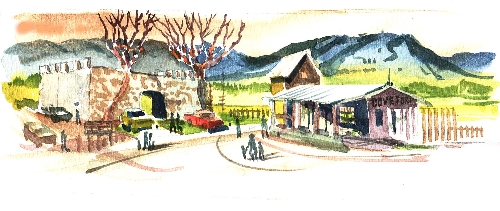Utah’s Old Cove Fort offers glimpse of pioneer life
Built solidly of native stone and timber, Utah's Old Cove Fort stands as a monument to pioneer resolve and dedication. In frontier times, it served as a travelers' wayside, family home, working ranch, stage stop, Pony Express station and communications center. Today, it attracts passers-by, welcoming them with an open door to the past.
Old Cove Fort sits at the junction of two major highways, Interstate 15 and Interstate 70, in south central Utah. It is about 230 miles from Las Vegas. Follow I-15 north into Utah, on a scenic route past St. George, Cedar City and Beaver. North of Beaver, watch for the I-70 turnoff. Take Exit 1 on I-70 and drive a mile north to reach the restored fort.
When Utah was being settled, little Cove Creek became a logical stopping point along a major overland trail from Salt Lake City to California. It had been in use for many years before Mormon leader Brigham Young decided it was a likely spot for a better-equipped wayside, though not for a large population because water was limited. In 1867, the church leader asked Ira Hinckley to establish such a facility.
Leaving his family at home in Coalville, Utah, Hinckley traveled to the site, where a wooden palisade-style fort stood abandoned. He marked out a new structure in the form of a square measuring 100 feet on each side. Workers and craftsmen - church members from established communities - helped build the new fort. Sheltered in the old palisade, work crews labored from April to November 1867.
Hinckley found sources of stone, putting men to work quarrying limestone and lava for foundations and walls. Other crews cut timber for framing, doors, moldings, furniture and outbuildings. Set on limestone blocks, the black lava walls rose 18 feet high, tapering from 4 feet at the base to 2 feet at the top. Rifle ports commanded defensive positions. Large wooden doors at the east and west ends allowed wagons to be brought inside the compound. The north and south walls formed the back of 12 rooms along either side.
Despite its fine defensive capabilities in a time of unrest on the frontier, Cove Fort never had to be defended. It became the Hinckley family's home with orchards, gardens, poultry and dairy cattle that provided amply for the family and guests who arrived daily for stagecoach stopovers.
As many as 75 guests were often fed and housed. The fort was headquarters for a church-owned ranch with tithing herds of cattle and other livestock tended by cowboys. It functioned as a post office and a station on a telegraph line. A blacksmith who created many useful items from iron was on hand to repair wagons and equipment, doubling as a farrier.
For two decades, Old Cove Fort was a busy place, but by the 1890s, authorities decided to lease it out and later to sell it. It was occupied by the same family for nearly 100 years.
In 1987, the Hinckley family raised money to buy the property back. The Hinckleys then donated Old Cove Fort to The Church of Jesus Christ of Latter-day Saints for restoration. After several years of careful research, reconstruction and refurnishing, the fort was named a Mormon historical site in 1994 in a ceremony conducted by future church president Gordon B. Hinckley.
Today, Old Cove Fort is open to visitors year-round free of charge. Living on-site, church members serving missions guide visitors through the property from early morning until just before sunset. Allow about an hour for the free tour, which starts with an informative film in a small visitor center.
Attractive landscaping shrubs and flowers border well-tended grounds and walkways leading to the fort's entrance. The rooms inside the fort show how the pioneers lived. Authentic period furnishings include pieces from the fort's early days.
A productive vegetable garden behind the fort looks much like the truck gardens of yesteryear. Some of the trees on the property and inside the fort's walls date from those early years.
Tours include the fine barn, the stone blacksmith's shop and a stroll past Ira Hinckley's original cabin, moved there from Coalville. Facilities include parking, picnic areas and restrooms.
Margo Bartlett Pesek's column appears on Sundays.







